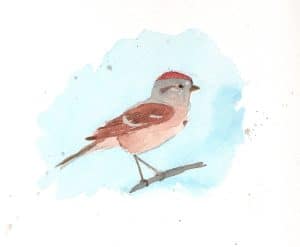
Winter has finally arrived. When the snow flies so do the birds, arriving at our feeders in larger numbers. We get many different little brown birds that on quick inspection we may lump together as “sparrows”. But on closer inspection, we see that they are house sparrows, female house finches, Carolina wrens, fox sparrows, song sparrows, white-throated sparrows and American tree sparrows. American tree sparrows arrive here in fall from their northern breeding grounds in Canada and Alaska. They closely resemble chipping sparrows, that leave us and head further south at in the fall. For a time, both chipping and tree sparrows may be on the ground under your feeder. But, by January, American tree sparrows predominate.
American tree sparrows are striped brown and tan on their backs. Their heads are grey with a rusty red cap and eye line. Their most distinctive feature is a clear white breast with a dark central dot. Through citizen science data reported to ebird, it has become obvious that this species is declining throughout most of its winter range (Cornell Lab of Ornithology, “Living Bird”, winter 2023). The reason for this decline is unclear, but is thought to be a result of agricultural pesticide use. These birds forage mostly on the ground, and so come into frequent contact with pesticides applied to lawns and agricultural lands.
As with most small birds, American tree sparrows need to eat about 30% of their body weight, and a similar amount of water daily in order to survive cold nights. When snow covers the ground, finding seeds on the ground may be very difficult. This is when your bird feeder can truly save lives. Birds feed heavily in early morning, and an hour or two before sunset, so check on your feeders frequently. Lets keep our beautiful birds coming!
Many thanks to flora and fauna reporters for the month of January. Please send reports by February 28, for inclusion in next month’s column. You can call me at 692-3907, write me at 7A Old Colony Drive, or e-mail me at mariancharman@gmail.com
——————————-
January Reports:
Marilyn Day, at Acker Land, January 1, bear scat (?) near the stone underpass.
Ron Gemma, Concord Rd. January 2, puffed up goldfinch at feeder, seemed to have eye disease.
Mark Minucci, January 4. Young, wet, great blue heron standing on the front lawn [Mark sent a photo of the wet bird-MH]
Marian/Bill Harman, Old Colony Drive. Wet snow on and off all day. January7, 30’s, sunny. A walk to the meadow: tracks of several deer of different sizes, fisher, a smaller weasel, rabbit, squirrel. Titmouse singing its “hear, hear” spring song, chickadee, blue jay, brown creeper, golden-crowned kinglet, white-breasted nuthatch, red-bellied woodpecker. January 8, a walk on the Mass Electric line: very quiet, downy woodpecker, goldfinch. January 9, 30 degrees, three goldfinches, six juncos, three crows, downy woodpecker, blue jay. On the beaver dam trail: lots of bird life, chickadees, titmice, two brown creepers flying around together, a Carolina wren, jays, three crows, one raven heard, red-bellied woodpecker, one hairy woodpecker heard and seen, a downy woodpecker, juncos, cardinal, goldfinches. January 14, flicker feeding on ground under our feeder. January 15, two male cardinals at the feeder, one house finch, one downy. January 16, 30’s, snowed about two inches. A good morning at the bird feeder: One pair of cardinals, pair of cardinals, two American tree sparrows, one house sparrow, one blue jay, one titmouse, 12-15 juncos, two chickadees, one white-breasted nuthatch, female red-bellied woodpecker, two titmice, two goldfinches, one mourning dove, two fox sparrows—beautiful! January 17, 40’s, a walk on the beaver dam trail: Red-tailed hawk, white-throated sparrow, American tree sparrow, a pileated woodpecker, a cardinal singing his beautiful song for the first time this year—he sounds like a canary—Spring is here! January 20, three or four inches of snow: At feeder, two chickadees, two titmice, two goldfinches, six juncos, two American tree sparrows, one house sparrow. January 21, 30’s, sunny, beautiful: one pair of house finches, four goldfinches, six juncos, one house sparrow, one blue jay, one cardinal one white-breasted nuthatch, about eight blue jays, juncos, song sparrow, red-breasted nuthatch, hairy woodpecker, downy woodpecker, red-bellied woodpecker, deer and fisher tracks on the trail. Chickadee heard singing its spring song for first time, “fee-bee”. January 27, 40’s, sunny. Pileated woodpecker calling loudly from the woods. January 29, 46 degrees, cloudy, mild. Lots of birds seen and heard. A walk to the beaver dam: cardinal, blue jays, chickadees, white-breasted nuthatch, red-breasted nuthatch, Carolina wren, winter wren (heard by Merlin), mourning doves, crows, bluebird, downy woodpecker, red-bellied woodpecker.
Gerry DiBello, Court Rd. January 19. Four bluebirds come to peanut chips. A cardinal likes to eat the thistle seed.
Diane Duane, Howard Rd. January 19, bluebirds come to sunflower chips and to mealworms at her feeder.
Marian Harman is a member of the Westford Conservation Trust, a non-profit conservation organization. The Trust’s purpose is the preservation of Westford’s open spaces and trails. Check out the Trust’s website at westfordconservationtrust.org, and visit us on Facebook.
